Hitachi Deskstar 7K1000: Terabyte Storage arrives on the Desktop
by Gary Key on March 19, 2007 8:00 AM EST- Posted in
- Storage
iPeak Video/Audio Tests
The iPeak based Video/Audio benchmarks are designed around simulating media encoding and HTPC activities. These are basic benchmarks at this time as this section will be expanded once we start testing under Vista. Our change to a dual core processor will assist us in maintaining a balance between the CPU and Storage systems during the trace file creation and benchmarking processes. These benchmarks are CPU intensive in nature but also require a balanced storage system with the ability to handle read and write requests simultaneously in a very efficient manner.
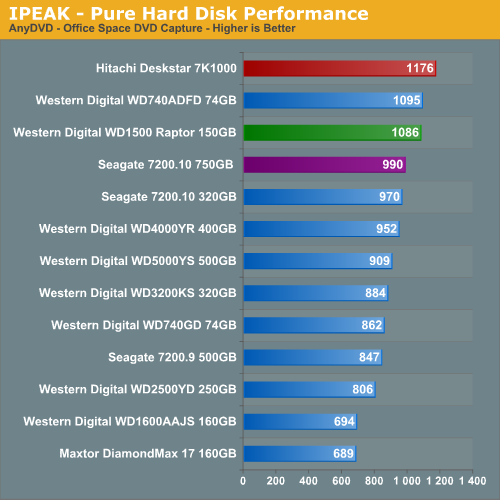
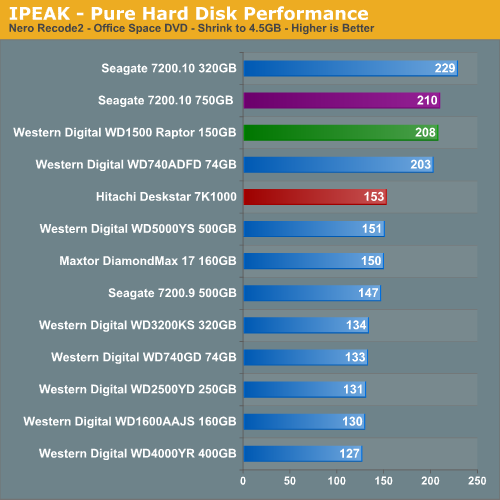
The AnyDVD benchmark is heavily weighted to write requests with the results showing a common pattern with the two 16MB cache Raptors finishing second and third with the 7K1000 once again showing its strength in the write intensive benchmarks due to its areal density and large cache design. We found the Seagate 750GB was pausing during streamed writes due to the smaller cache size after witnessing buffer overruns in the trace file when compared to the Hitachi drive.
The NeroRecode 2 benchmark is weighted to streaming read requests but is balanced by continuous write operations near the end of the test. This benchmark is one of the most demanding ones in our test suite with the disk being active the entire trace file with several 100% utilization peaks. The results surprised us as we expected the Hitachi with its 32 MB cache and high sustained transfer rates to handle this benchmark with aplomb.
However, it turns out after reviewing the trace file results it was obvious that the 7K1000 was hampered by its inability to process large data blocks in sequential order efficiently as it had a number of buffer overruns during the read portion of the tests. This indicates to us the drive firmware is probably tuned more for non-sequential read/writes as the rest of our tests indicate. However, the 32 MB cache should have easily compensated for any potential large block issues in this test and the drive handled previous read heavy request tests with ease. Our initial test results with AAM off only show a two point advantage in this test. We are currently completing tests with AAM/NCQ off and will update the article if there are any noticeable performance differences.
iPeak Game Installation Tests
Our iPeak based Game Installation benchmarks simply show the ability of the hard drive to write data as quickly as possible to the disc based upon the installation software instructions. As detailed in our iPeak setup description we installed the games from our source drive in order to eliminate the optical drive bottleneck. In separate application timing we witnessed basically the same percentage spread when installing the games via our DVD drive so these results are representative of actual installation performance.
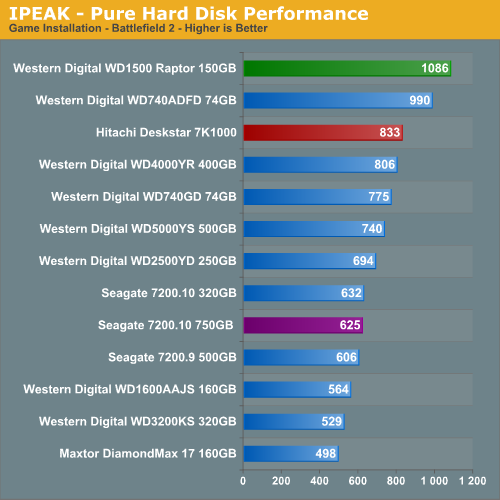
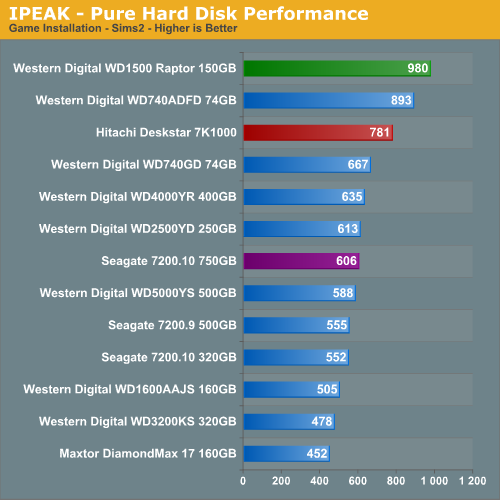
The Raptors once again finish at or near the top in our gaming tests due to their rotational and random access speeds. Our 7K1000 drive finishes ahead of the 7200rpm drives with a great deal of benefit going to the 32 MB cache and high sustained transfer rates. A review of the trace files did not indicate any real standout issues with the Seagate 750GB drive although we noticed several minor dips in performance when the drive was reading information off the source drive. The write performance was generally slower than the 7K1000 in this test and follow previous benchmark results.
We need to remember these tests reflect pure hard drive performance and will be mitigated by the overall system platform as we will see in our application tests. These tests are basically designed around continual read/write requests that favor large cache sizes, properly tuned firmware, and high sustained transfer rates.
iPeak Game Play Tests
The iPeak based Game Play tests are centered on the benefits of having a hard disk that can load non-linear or sequential data files quickly without interrupting the flow of the game.
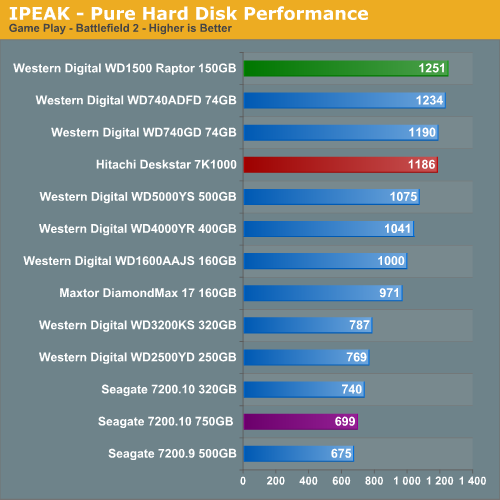
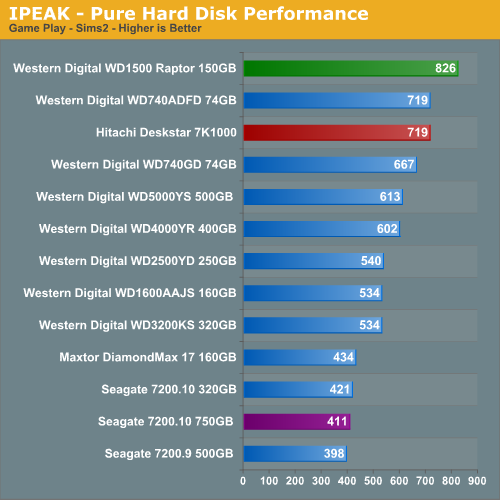
When it comes to gaming the Raptors rule but the 7K1000 is not that far behind with a second place tie in the disk intensive Sims2 and a strong fourth place finish in Battlefield 2. Although we are looking at pure performance results, in subjective testing we finally have a 7200rpm drive that "feels" as fast as the Raptor family of drives when loading or playing a game. The best overall gaming performance in a drive with a SATA interface is still the Raptors but considering the storage size, acoustic, and cost per-Gigabyte advantages of the Hitachi drive we are heavily leaning towards changing our recommendation.
The iPeak based Video/Audio benchmarks are designed around simulating media encoding and HTPC activities. These are basic benchmarks at this time as this section will be expanded once we start testing under Vista. Our change to a dual core processor will assist us in maintaining a balance between the CPU and Storage systems during the trace file creation and benchmarking processes. These benchmarks are CPU intensive in nature but also require a balanced storage system with the ability to handle read and write requests simultaneously in a very efficient manner.


The AnyDVD benchmark is heavily weighted to write requests with the results showing a common pattern with the two 16MB cache Raptors finishing second and third with the 7K1000 once again showing its strength in the write intensive benchmarks due to its areal density and large cache design. We found the Seagate 750GB was pausing during streamed writes due to the smaller cache size after witnessing buffer overruns in the trace file when compared to the Hitachi drive.
The NeroRecode 2 benchmark is weighted to streaming read requests but is balanced by continuous write operations near the end of the test. This benchmark is one of the most demanding ones in our test suite with the disk being active the entire trace file with several 100% utilization peaks. The results surprised us as we expected the Hitachi with its 32 MB cache and high sustained transfer rates to handle this benchmark with aplomb.
However, it turns out after reviewing the trace file results it was obvious that the 7K1000 was hampered by its inability to process large data blocks in sequential order efficiently as it had a number of buffer overruns during the read portion of the tests. This indicates to us the drive firmware is probably tuned more for non-sequential read/writes as the rest of our tests indicate. However, the 32 MB cache should have easily compensated for any potential large block issues in this test and the drive handled previous read heavy request tests with ease. Our initial test results with AAM off only show a two point advantage in this test. We are currently completing tests with AAM/NCQ off and will update the article if there are any noticeable performance differences.
iPeak Game Installation Tests
Our iPeak based Game Installation benchmarks simply show the ability of the hard drive to write data as quickly as possible to the disc based upon the installation software instructions. As detailed in our iPeak setup description we installed the games from our source drive in order to eliminate the optical drive bottleneck. In separate application timing we witnessed basically the same percentage spread when installing the games via our DVD drive so these results are representative of actual installation performance.


The Raptors once again finish at or near the top in our gaming tests due to their rotational and random access speeds. Our 7K1000 drive finishes ahead of the 7200rpm drives with a great deal of benefit going to the 32 MB cache and high sustained transfer rates. A review of the trace files did not indicate any real standout issues with the Seagate 750GB drive although we noticed several minor dips in performance when the drive was reading information off the source drive. The write performance was generally slower than the 7K1000 in this test and follow previous benchmark results.
We need to remember these tests reflect pure hard drive performance and will be mitigated by the overall system platform as we will see in our application tests. These tests are basically designed around continual read/write requests that favor large cache sizes, properly tuned firmware, and high sustained transfer rates.
iPeak Game Play Tests
The iPeak based Game Play tests are centered on the benefits of having a hard disk that can load non-linear or sequential data files quickly without interrupting the flow of the game.


When it comes to gaming the Raptors rule but the 7K1000 is not that far behind with a second place tie in the disk intensive Sims2 and a strong fourth place finish in Battlefield 2. Although we are looking at pure performance results, in subjective testing we finally have a 7200rpm drive that "feels" as fast as the Raptor family of drives when loading or playing a game. The best overall gaming performance in a drive with a SATA interface is still the Raptors but considering the storage size, acoustic, and cost per-Gigabyte advantages of the Hitachi drive we are heavily leaning towards changing our recommendation.










74 Comments
View All Comments
mikeg - Thursday, April 26, 2007 - link
Its been a over a month since the article came out and I still don't see any in the retail stores or a non OEM drive. Where can I get one?? Anyone see a retail box of these drives a a retailer? I want to get a coupleMike
jojo4u - Monday, March 26, 2007 - link
Hello Gary,the Hitachi datasheet refers to three idle modes using APM. The results with AAM enabled could suggest that APM is automatically engaged with AAM. So perhaups one should check the APM level with Hitachi's Feature Tool or the generic tools http://hdparm-win32.dyndns.org/hdparm/">hdparm or hddscan.
Gary Key - Friday, March 30, 2007 - link
We had a lengthy meeting with the Hitachi engineers this week to go over APM and AAM modes along with the firmware that is shipping on the Dell drives. I hope to have some answers next week as testing APM capabilities on a Dell based system resulted in a slightly different behavior than our test bench. I have completed the balance of testing with various AAM/NCQ on/off combinations and some additional benchmark tests. I am hoping to update the article next week. Also, I ran acoustic tests in a different manner and will have those results available. Until, then I did find out that sitting a drive on a foam brick outside of a system and taking measurements from the top will mask some of the drives acoustic results. The majority of noise emitted from this drive comes from the bottom, not the top. ;)ddarko - Monday, March 26, 2007 - link
"However, Hitachi has informed us they have the capability to go to 250GB per-platter designs but launched at smaller capacities to ensure their reliability rate targets were met. Considering the absolute importance of data integrity we think this was a wise move."This sounds like an sneaky attempt by Hitachi to raise doubt about the safety of Seagate's forthcoming 1TB drive. Where is the data to support this rather bold statement that 250GB platters designs are not as capable as 200GB designs of meeting these completely unspecified "reliability rate targets"? What does that even mean? Can we infer that 150GB platter designs are even more reliable than 200GB designs? It's disappointing to see the review accept Hitachi's statement without question, going so far as to even applaud Hitachi for its approach without any evidence whatsoever to back it.
Lord Evermore - Thursday, March 22, 2007 - link
While I know memory density in general isn't increasing nearly as fast as hard drive size, 32MB cache seems pretty chintzy for a top-end product. I suppose 16MB on the 750GB drives is even worse.My first 528MB hard drive with a 512KB cache was a 1/1007 ratio (using binary cache size, and labelled drive size which would be around binary 512MB). Other drives still had as little as 128KB cache, so they could have been as little as a 1/4028 ratio, but better with smaller drives. I think anything larger than 512MB always had 512KB.
A 20GB drive with 2MB cache is 1/9536 ratio.
A 100GB drive with 2MB cache is 1/47683.
Then the jump to 8MB cache makes the ratio much better at 1/11920 for a 100GB drive (I'm ignoring the lower-cost models that had higher capacities, but still 2MB cache). Then it gets progressively worse as you get up to the 500GB size drives. Then we make another cache size jump, and the 160GB to 500GB models have a 16MB option, which is back to 1/9536 on a 160GB, to 1/29802 on a 500GB.
The trend here being that we stick with a particular cache size as drive size increases so the ratio gets worse and worse, then we make a cache size jump which improves the ratio and it gets worse again, then we make another cache size jump again.
Now we go to 750GB drives with 16MB cache. Now we are up to a 1/44703 ratio, only the 2nd worse ever, seems like time for another cache increase. Jumping to 32MB with a 100TB drive only makes it 1/29802. Not a very significant change despite doubling the cache again, since the drive size also increased, and it'll only get worse as they increase the drive size. Even 32MB on a 750GB drive is 1/22351, only slightly better than the 16MB/500GB flagship drives when they came out, and we don't even HAVE a 32MB/750GB drive.
A 512MB cache would be nice. That's still not the best ratio ever, it's still 1/1862, but that's a heck of a lot better than 1/30,000th. At the very least, they need to jump those cache chip densities a lot, or use more than one. Even a single 512MB density chip would be 64MB, still not great but better.
Per Hansson - Sunday, March 25, 2007 - link
Bigger caches would almost make it a necessity that you run the system on a UPS.Loosing 32mb of data that is yet to be written to the platters is allot, but 512mb?
And the UPS would not take into account OS crashes...
I'm not sure how much this would affect performance either, but a review of a SCSI drive with a SCSI controller with 2mb - 1gb of cache would answer that question well...
yehuda - Wednesday, March 21, 2007 - link
Do they plan to launch a single platter variant sometime in the near future?Gary Key - Wednesday, March 21, 2007 - link
They will be releasing a 750GB variant in May. Our initial reports have the single platter drives along with the 300~500GB models coming later in the summer. I am trying to get that confirmed now.DeathSniper - Tuesday, March 20, 2007 - link
Last page..."The Achilles heal of the Seagate 750GB drive..."I think it should be heel, not heal ;)
Spacecomber - Tuesday, March 20, 2007 - link
While this drive has enough in the way of other features to make it stand out from the crowd, I was a bit surprised to see that Hitachi hadn't upped the warranty to 5 years for this drive, which is what Seagate offers on most of their drives and WD offers on their raptors.